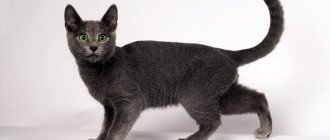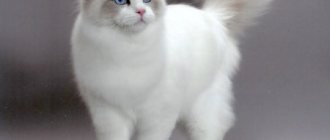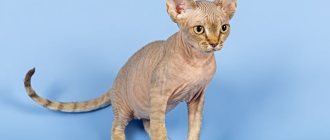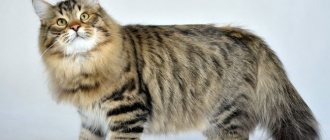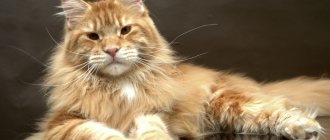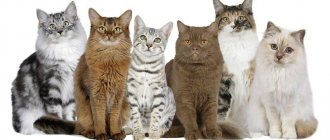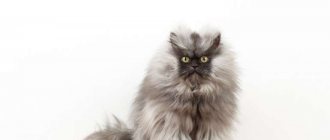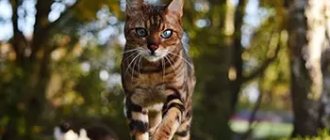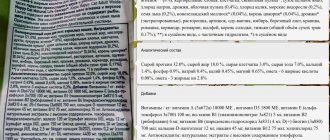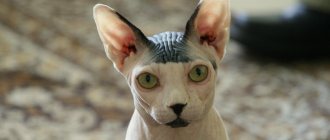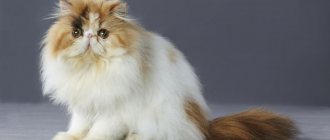Cats have long taken their rightful place on the list of the most popular pets. But many people are not ready to put up with heavy shedding and it is because of this that they deny themselves the pleasure of having a purring pet. Especially for them, breeders have developed several breed varieties, whose fluff does not settle in clumps on clothes and furniture.
Let's figure out which cat breeds don't shed and what to do to prevent them from smelling.
Features of non-shedding breeds
The shedding process is considered a physiological norm for most breeds of domestic cats. Therefore, they all lose their fur to one degree or another. Of course, those with short fur coats shed less fluff than their shaggy counterparts with a voluminous undercoat.
All low-shedding breeds have a number of features:
- absence of down or guard hair;
- presence of coarse or curly hair.
Thanks to this, such cats hardly shed, and are also less likely to cause allergies.
Devon Rex
These unusual pets appeared in England in 1959, surprising with wavy shaggy curls and thin, sometimes bald, suede-like hair. These cats cannot be called large: males can grow up to 3.6-4.5 kg, and females - up to 2.3-3.2 kg. They shed just like other cats, but the lack of guard hairs makes the shedding less noticeable than in other breeds.
The peculiarity unique to this species is an expressive and surprisingly meaningful look. These cats constantly change their facial expressions: from lovingly romantic to proudly offended, which gives them a fabulous look.
Representatives of the Devon Rex breed can be of different colors, but there is no matching color of coat and eyes. The exceptions are the color point color, which is characterized by blue eyes, and the color of Tonkinese cats with aquamarine eyes.
Cats of this English breed are very smart, easily remember nicknames and are trainable. They are very affectionate towards their owner, which cannot be said about their brothers: Devon Rex cats can even be at enmity with some cats.
These pets need to be bathed frequently because the secretions of the sebaceous glands are poorly absorbed by the short hair, and the animals quickly become dirty and sticky.
List of breeds that do not shed or smell
Experts work tirelessly to develop varieties that do not smell and hardly shed hair. And they have already managed to achieve certain results.
The list of existing cat breeds that do not shed or smell under certain conditions includes:
- naked cats;
- rexes;
- Siamese-Oriental group;
- Russian blue;
- Nibelung;
- Bengal.
Hairless cats
These are partially or completely hairless cats with thick, hot skin. This category includes:
- all types of sphinxes (Canadian, St. Petersburg and Don);
- selective breeds obtained with the participation of hairless cats (Ukrainian Levkoy, Dwelf, Elf and Bambino).
Canadian Sphynx
Peterbald cat
Don Sphinx
All sphinxes are conventionally divided into subgroups:
- Naked. Such cats are born without topcoat hair and without undercoat. They often do not have eyebrows or mustaches.
- Flock and velor. These Sphynx cats have a light undercoat. In some of them, fluff grows all over the body, in others - only on the muzzle and certain parts of the body.
Although hairless cats have virtually no hair, they require careful grooming. They secrete a specific secretion that accumulates on the skin and begins to smell unpleasant. In addition, sphinxes can leave greasy stains on upholstered furniture. Therefore, it is recommended that hairless cats be wiped daily with wet wipes and bathed frequently.
Sphynxes also need a special diet, any deviation from which causes them to sweat profusely. As a result, acne appears on their skin.
Rex
This group of cats, which do not shed or smell, includes breeds with short, wavy fur and no undercoat. Rex species include:
- Devon Rex with hypoallergenic, virtually odorless coat. He does not shed at all, but due to skin secretions, his fur quickly becomes greasy and requires frequent washing.
- Cornish Rex with a sparse undercoat that looks like fluff. Due to its elongated muzzle and large eyes, it is often compared to an alien.
- Selkirks, Laperms, German and Ural rexes with a curly coat reminiscent of sheep's fleece. Representatives of these breeds can have both short and long hair.
Devon Rex
Cornish Rex
Selkirk Rex
Laperm
Ural Rex
All these cats, when properly cared for, have virtually no odor, are not prone to heavy shedding and do not need to be combed. Unlike sphinxes, rexes are not afraid of cold weather and do not require complex care.
True, with an unbalanced diet, dark spots appear on their back and sides. Therefore, owners will have to carefully monitor the diet of curly-haired cats.
Siamese-oriental group
It unites cat breeds whose ancestors lived in countries with warm climates and did not have the need to shed their fur coats.
The Siamese-oriental group includes:
- Siamese;
- Abyssinians;
- orientals;
- Thais;
- Burmese;
- Balinese;
- skif-tay-dons;
- Mekong Bobtails.
Siamese cat
Abyssinian cat
Oriental cat
Thai cat
Burmese cat
Balinese cat
Skif-tay-don
Mekong Bobtail
All of them have short, shiny hair that lies close to the body and does not require special care. Their guard hair changes almost imperceptibly, and to maintain a neat appearance it is recommended to iron them daily with wet hands.
Important! Cats of the Siamese-Oriental group practically do not shed and do not smell. If oriental pets have severe awning, they must be shown to a veterinarian. Excessive shedding, which is unusual for them, can be caused by stress, hormonal imbalances and serious diseases.
Russian blue
Despite the fact that this cat practically does not shed and does not smell, it has both a luxurious coat and a thick undercoat. The hair of the Russian Blue has a unique structure that does not allow it to break. Due to this, the cat changes its coat throughout the year, but at the same time sheds unnoticed by its owners.
On a note. Russian Blue does not require special care. Her lightly shedding hair is not recommended to be combed out frequently and washed using aggressive products.
Nibelung
This non-shedding cat is very similar to the Russian Blue. But, unlike the latter, the Nibelung has a semi-long coat. The unusual fur of a cat of this breed is characterized by reduced fragility, due to which it practically does not shed.
Bengal
This hybrid of a wild and domestic cat is almost non-shedding and odorless. The main feature of the Bengal is that at the age of a week it begins to phasing. During this natural process, the cat's coat becomes shorter than the undercoat, and the bright spotted coloring becomes covered with a dark veil.
At the age of 4-9 months, the Bengal's fur falls out completely, and the hair becomes smooth and shiny. Subsequently, the undercoat of a hybrid cat does not grow, which means it never sheds again.
Sphinx (Canadian sphinx)
The Sphynx is the only breed in the world that has minimal fur. They arose back in 1966 in Canada as a result of a spontaneous gene mutation. Since then, breeders have been actively breeding these animals.
Externally, the extraordinary Sphynx is a medium-sized cat with strong bones, well-developed muscles, wide eyes and overly large ears. They have virtually no whiskers, but some individuals may retain them. Due to the width of the chest, the paws of sphinxes are always widely spaced, and the limbs themselves are thin with long fingers.
Canadians are famous for their folds on the forehead, neck and limbs: even if you stretch the cat to its full length, the folds will still be present. Signs of fur are observed only in the form of fluff, which makes their skin similar to the skin of a child. This breed can be classified as one of those that sheds the least.
Interesting. The Sphynx is the only cat endowed with sweat glands, which are involved in creating color. As a result of sweating, your pet can leave greasy stains on furniture and floors.
The face of sphinxes is quite intelligent, and their facial expressions are very friendly. These pets quickly become attached to their owner, do not remember insults and cannot stand loneliness.
Pros and cons of non-shedding cats
A cat that doesn't shed has its advantages and disadvantages:
| pros | Minuses |
| No loose hair on carpets and furniture | Difficulty in skin care (hairless breeds) |
| Hypoallergenic | Special dietary requirements (for Sphynxes) |
| No need for frequent brushing |
The list of cats that don't shed or smell when properly cared for includes many dissimilar breeds. Therefore, it will certainly be useful not only for allergy sufferers, but also for those who dream of a four-legged pet, but are not ready to put up with balls of cat hair and the need to frequently clean.
Cornish Rex
The Cornish Rex breed is often called alien cats due to their unusual appearance. The structure of the fur coat of these short-haired pets resembles astrakhan fur, since waves of different depths and widths are dispersed throughout the woolen blanket. Their large mysterious eyes and huge ears also attract special attention.
The color palette of the breed includes many colors and their combinations, asymmetrical patterns and white spots against the background of the main color.
This is interesting: Yulia Peresild and her Husband
The character of Cornish Rex creatures has a lot of positive aspects:
- friendliness and affection for the owner;
- sociability and high activity;
- perfect memory and desire to help the owner in daily affairs.
Due to their high mobility, these creatures have a gigantic appetite, destroying huge amounts of food. In view of this feature, it is necessary to monitor the diet of such a cat, otherwise it will gain excess weight.
Cornish Rexes are a very healthy cat variety. With sufficient care and constant activity, these animals can live up to 20 years or longer. From 16 weeks of age, kittens must be taught to bathe, since the amount of hair is not enough to absorb sebaceous secretions, which can lead to the development of skin diseases.
Thai
The standard for this breed was registered relatively recently, in 1990. In appearance, Thai cats resemble rounded Siamese cats with shorter legs.
Thais are unpretentious and affectionate. Their shedding is rare and does not create problems because there is no undercoat. Animals do not have fatty or sweat glands, which eliminates their unpleasant odor.
Mekong Bobtail
The lack of a distinct odor in representatives of this breed has a genetic cause.
Mekong Bobtails are excellent hunters, capable of tracking prey for hours and the presence of even the slightest scent would give them away.
Pets have short and smooth fur. Bobtails take good care of themselves, which allows them to always be clean. This breed does not mark territory and does not cause problems due to its coat.
A distinctive feature of bobtails is a very short tail, which is not typical for other cat breeds.
Laperm
A breed of cat with a distinctive appearance.
She has curly fur. The name comes from the English “perm” - perm. The first lapermas were bred on a farm in Orinoco. Where, starting in 1980, curly-haired cats, not yet recognized, were kept in a semi-free state. Selectors and breeders paid attention to cats. Since 1990, cats began to participate in exhibitions
In 1997, the breed standard was published. According to which Laperm are cats with a muscular, not heavy body, long limbs and neck. The head is wedge-shaped with smooth transitions. The eyes are almond-shaped. The ears are quite large, slightly set apart.
There are two versions of the breed: longhaired and shorthaired. Both have curly fur. Messy curls give the appearance of dishevelment. The standards allow for a wide variety of colors, except striped and brindle.
Cats are very affectionate. Truly homemade. They retain their playful character until old age. Breeders advertise the animal as hypoallergenic. However, people with a tendency to allergic reactions should be careful and wash the animal more often.
Russian blue
The cat is known for its characteristic silver color. The eyes must have a green tint. The fur is very thin and short, making the animal look quite neat.
Reviews from the owners say that these are incredibly gentle and touching creatures. The cat will never show signs of aggression; on the contrary, it is extremely affectionate.
Popular sphinxes
Which cats don't shed? This question is most often of interest to those who suffer from certain allergic diseases. This is an almost hairless breed, since Canadians either have no hair or can be up to 2 mm long, resembling a pile. The first Sphynx appeared in 1966, when an ordinary cat with hair in Canada gave birth to completely hairless kittens.
The Peterbald, or St. Petersburg Sphynx, has no fur. Its skin resembles a rubber surface, differing in sensitivity to the sun. Among the completely hairless cats, one can highlight the Don Sphynx.
Manufacturers
Almost all leading brands of grooming products are engaged in the production of brushes for pet care. Among them, “Hello Pet” (Taiwan) stands out, which offers a wide range of tools at an average cost of 300-1000 rubles. Products from this company can be found in both large and small pet stores.
(Russia) offers not only grooming tools, but also other important accessories for pets. These include carrier bags, dog clothing and rodent cages. It is Triol that is famous for its huge number of products at an affordable price (100-400 rubles), intended for all types of pets.
German brush “Trixie”
The German brand “Trixie” is distinguished by the increased cost of its products (from 200 and more than 1000 rubles). However, their company's instruments are of high quality, which are often spoken positively about.
"VIPet" (Russia) is engaged in the production of ammunition and parts for leashes, collars, etc. Under this brand you can also find dog grooming products, toys and other products for dogs and cats. On average, instruments are sold for 180-900 rubles.
This is an incomplete list of companies that provide grooming tools to the buyer. You can often find “Dezzie” (Russia), “Nobby” (Germany), “Flamingo” (Belgium), etc. in stores.
We recommend giving preference to products made from natural materials. If possible, it is better to avoid brushes with metal teeth, as for the delicate and very sensitive skin of a cat, they can not only become a source of discomfort, but also cause serious damage.
Don Sphynx
The birthplace of the Don Sphinx is Rostov-on-Don. In 1987, a hairless cat was picked up on the street and was treated for baldness for a long time and without success. In fact, the lack of hair turned out to be a consequence of a gene mutation, and breeders began to form a new breed.
Externally, the Don Sphynx is characterized by:
- strong muscular body, often pear-shaped;
- wedge-shaped head, folded forehead, “masculine” chin, straight nose, large ears with rounded tips, medium-sized almond-shaped eyes, curly mustache (may be completely absent);
- long graceful paws with elongated toes, a long straight tail with a rounded end.
The weight of adult gentlemen reaches 7 kg, and ladies grow no more than 5 kg. Any color is allowed: black, white, red, red, gray, blue.
Representatives of the breed are very playful and enjoy new toys, like little children. They are not jealous at all and get along easily with other pets. Despite all their friendliness, these cats are very touchy.
Attention. Some people mistakenly believe that the absence of hair in an animal is a sign of hypoallergenicity. In fact, the main culprit of allergies is a glycoprotein found in cat saliva.
We offer you to read the full article on the Don Sphynx cat breed.
Cornishrex
© shutterstock Cornish Rex cats are quite unique looking cats, as they have sparse fur and no guard hairs, which make up the top layer of fur that often protects cats from water.
As you might have guessed, no guard hair means he loses less fur! These cats are very sociable and love human interaction. They are also slow to mature and will exhibit kitten-like behavior as adults. Read also: Bug-eyed animals (photo)
History of the Turkish Angora
The Turkish Angora is an indigenous breed of cat that has lived in the territory of modern Turkey since ancient times. It is named after the capital of the Ottoman state - Ankara.
Felinologists have proven that the angora is a descendant of a wild African cat domesticated by humans. There is a version that over time, these pets underwent two gene mutations: as a result of the first, their fur became longer; and as a result, the second one turned white.
The Turkish Angora cat breed was considered the most revered by the Ottomans. Only very rich people, for example, the Sultan and high dignitaries, could afford such an expensive pet.
Since the 16th century, Angora cats began to win the love of Europeans. Many Christian monarchs kept them. Catherine the Great accepted a snow-white long-haired purr as a gift from Count Potemkin.
Subsequently, Angoras mixed with Persian ones, which almost led to the degeneration of the breed. British and Turkish breeders began to restore the lost original characteristics. The result of colossal work was the official registration of the Angora cat breed in 1969.
Shorthair
If you don’t like completely hairless cats, as well as their unusual appearance, then you should pay attention to the graceful representatives among short-haired cats.
Attention! Most individuals have short hair and a small undercoat, so caring for them is very easy.
Of course, if you are choosing which cats do not shed at all, then this breed will not be the best choice for you. We offer an overview of popular shorthair breeds:
- With regular short hair. These animals have undercoat and guard hair of different lengths. Popular among them are the American Curl, European Shorthair, and Kuril Bobtail. They will appeal to those who are choosing which breed of cat sheds the least among shorthairs.
- Plush (with double wool). These representatives have an undercoat equal in length to the awn. Among the popular individuals are the British, Russian blue breed, and exotics.
- Semi-longhaired. There is such a breed. They come in different varieties: without undercoat, like the Javanese, Balinese and Turkish Angora, and with undercoat, like Siberian cats, Karelian Bobtails and Maine Coons. These cats shed a lot, so caring for them is not the easiest.
The American Curl sheds the least among shorthairs.
In general, representatives of the breeds described above will have to be combed frequently. For example, a British cat has very short, soft and thick hair, and the undercoat is very well developed. Accordingly, you need to take care of them every day. The American Curl is distinguished by a small undercoat with a fairly long coat, so it also needs to be combed at least once every 2 weeks.
Separately, it is worth mentioning the Kuril Bobtail, whose coat does not require special care. He is one of the cat breeds that sheds little. The peculiarity of the bobtail coat is that it does not mat due to the hard and long outer hair, and the wool practically does not shed.
Balinese
The Balinese breed comes from the Siamese, there are practically no differences between them except for the length of the coat. The Balinese are distinguished by a chic fluffy tail, which they carefully care for.
However, due to the lack of undercoat, these cats do not form tangles, and shedding is almost unnoticeable.
What you need to know about cat shedding
Any cat with fur, regardless of breed, sheds hair. Like human hair, animal hairs have a certain life cycle, after which they die and fall out. This is completely normal.
But owners of four-legged friends need to know when shedding is normal and when it is pathological..
- Natural seasonal shedding. It usually occurs twice a year - in autumn and spring. The fur grows more intensively in the spring, at which time the cat sheds its undercoat. This coat change lasts from 3 weeks to 1.5 months. To speed up coat renewal, it is recommended to brush your cat daily.
- "Apartment molt" syndrome. The problem may arise with a pet that lived on the street, but then got into the house. While in an apartment, the cat ceases to feel the seasons of the year, and constant exposure to warmth instinctively causes the animal’s skin to shed its fur. The adaptation period may take a year or more. All this time the cats are constantly shedding.
- Molting on a hormonal background. The desire to mate is inherent in every living creature at the genetic level. When a domestic cat begins to ask for a partner and does not get what she wants, a hormonal imbalance occurs (just like in humans). An increase in certain hormones causes hair loss. The problem is solved by mating or special drugs that suppress sexual desire.
- Stress. Pets are susceptible to stress. Poor treatment, especially beating, the appearance of another animal, or the prolonged absence of a beloved owner can cause anxiety in a cat. Some cats become jealous of new children in the family. During periods of stress, many “fluffies” shed. In such cases, it is recommended to give the unfortunate person sedative drops.
- Poor nutrition. Even if you choose a cat that sheds the least, its fur will begin to fall off in clumps from poor quality nutrition. Food from the human table is not suitable for domestic cats; they need special food containing all the necessary vitamins and minerals for healthy skin and coat.
- Disease. Some diseases are almost asymptomatic at first and are difficult to notice right away. Shedding due to illness may be accompanied by such signs as a foul odor from the cat’s mouth, poor appetite, and lethargy. The urine may smell more intense and unpleasant. If any strange signs are detected, the animal must be immediately taken to the veterinarian.
Siamese-oriental group
The most profitable options from the Siamese-Oriental group for a person who does not want to deal with the fact that his pet has begun to shed intensively are the following breeds:
If cats belonging to these groups begin to shed heavily, then an urgent need to look for the cause, since such a phenomenon cannot be called normal. The most common factors are:
In this case, it is best to show your pet to a doctor who can dispel doubts and, if necessary, recommend a normal treatment regimen and measures. After their use, the animal should stop pathologically shedding.
Tips for owners of shedding animals
If your choice fell on an animal with normal or heavy shedding, the situation can still be alleviated.
Reducing shedding
There are several ways to reduce natural hair loss.
Nutritious food
Analyze the animal's diet. It should have a lot of protein. A month before shedding, give your pet B vitamins and fatty acids. The medications and the regimen for taking them must be prescribed by a veterinarian.
It is useful to keep cat grass or sprouted oats at home - cats usually eat them with pleasure, replenishing the supply of nutrients in the body.
Cats instinctively love to eat grass that is good for them.
For long-haired breeds, it is recommended to use a paste that makes it easier to remove hair from the stomach.
